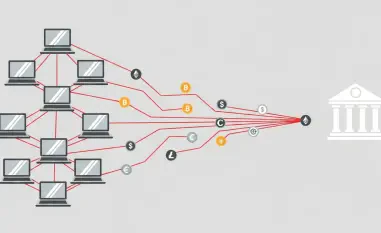In the ever-shifting landscape of cybercrime, a new and formidable threat has emerged, capturing the attention of cybersecurity experts worldwide with its innovative and aggressive approach to ransomware deployment. This operation, known as DragonForce, has rapidly risen to prominence by leveraging the leaked source code of the infamous Conti ransomware, transforming it into a sophisticated tool of digital extortion. What sets this group apart is not just its technical prowess but its adoption of a cartel-like structure, a strategic shift that mirrors organized crime syndicates in the physical world. Unlike traditional ransomware-as-a-service models that focus solely on distributing malicious software, DragonForce emphasizes collaboration, branding, and territorial dominance among its affiliates. This evolution signals a troubling trend in the cybercrime ecosystem, where power and influence are becoming as critical as financial gain, posing unprecedented challenges to organizations striving to protect their digital assets.
A New Breed of Cybercrime Organization
The foundation of DragonForce’s operation lies in its roots with Conti, inheriting core encryption mechanisms like ChaCha20 and RSA, which generate unique keys for each file and offer multiple encryption modes such as full, partial, and header-only. Beyond technical capabilities, the group has distinguished itself by actively recruiting affiliates to develop branded ransomware variants, significantly expanding its reach across vulnerable networks. This strategy not only amplifies the impact of their attacks but also creates a network of collaborators who customize and deploy the malware, targeting both local storage and network shares through SMB protocols. Such tactics demonstrate a calculated effort to maximize disruption, as the group threatens data leaks and decryptor deletion on tight deadlines, pressuring victims into compliance. This blend of inherited technology and innovative distribution marks a significant departure from conventional ransomware operations, highlighting a focus on scalability and sustained impact in the digital realm.
Another striking aspect of this ransomware operation is its cartel-inspired model, which fosters a sense of unity and shared branding among its affiliates. A notable example is the transition of groups like Devman, which moved from using a Mamona-based variant to adopting DragonForce’s builder for more effective ransomware deployment. This collaborative framework encourages affiliates to work under a unified banner while tailoring attacks to specific targets, enhancing the group’s adaptability and resilience. The aggressive campaigns mounted by DragonForce further underscore this approach, with relentless pressure tactics designed to coerce victims into paying ransoms swiftly. By integrating Conti’s robust encryption with a structured affiliate system, the group has positioned itself as a dominant force, capable of orchestrating widespread attacks while maintaining a cohesive identity. This shift toward organized collaboration reveals a deeper intent to control and influence the ransomware landscape beyond mere financial motives.
Strategic Alliances and Competitive Hostility
DragonForce’s growth is also fueled by strategic partnerships that amplify its threat potential, most notably with groups like Scattered Spider, known for providing initial access for other ransomware entities such as BlackCat and Qilin. These alliances have been linked to high-profile incidents, including a significant attack on a major UK retailer, showcasing the devastating impact of such collaborations. By aligning with skilled access brokers, DragonForce ensures a steady pipeline of compromised networks, allowing for more frequent and impactful ransomware deployments. These partnerships reflect a broader trend in cybercrime, where specialized roles and cooperative efforts are becoming commonplace, enabling groups to execute complex attacks with greater efficiency. The ability to leverage external expertise while maintaining internal cohesion positions DragonForce as a leader in this evolving ecosystem, raising concerns among security professionals about the escalating sophistication of such threats.
Equally alarming is the group’s hostile stance toward competitors, a tactic that further cements its ambition for dominance. Actions such as defacing the leak site of rival BlackLock and attempting to seize control of Ransomhub’s servers illustrate a willingness to engage in digital turf wars. These aggressive moves not only disrupt competing operations but also serve as a signal to potential affiliates, encouraging defections to DragonForce or allied groups like Qilin. Research from threat analysis units has described this behavior as a deliberate rebranding strategy aimed at consolidating power and expanding influence within the ransomware arena. This competitive posturing highlights a shift in focus from purely monetary objectives to establishing control over critical cybercrime infrastructure. As these power dynamics intensify, the ripple effects are felt across the industry, with smaller players either aligning with dominant groups or facing elimination from the landscape.
Defensive Imperatives in a Changing Threat Landscape
As ransomware groups like DragonForce adopt more organized and collaborative structures, the urgency for robust cybersecurity measures has never been greater. Enterprises must prioritize comprehensive strategies to mitigate the risks posed by such sophisticated threats, starting with strong backup practices to ensure data recovery in the event of an attack. Network segmentation is equally critical, limiting lateral movement and containing breaches before they escalate. Monitoring access to shared resources, consistent patching of vulnerabilities, and deploying advanced endpoint protection are essential steps to fortify defenses. Additionally, user awareness training plays a pivotal role in reducing the likelihood of phishing and other social engineering tactics that often serve as entry points for ransomware. These combined efforts address the vulnerabilities exploited by financially motivated actors, offering a multi-layered approach to safeguarding sensitive environments against evolving digital threats.
Beyond immediate defensive tactics, organizations must adopt a proactive mindset to stay ahead of cartel-like ransomware operations. This involves continuous monitoring of threat intelligence to anticipate emerging attack vectors and adapting security protocols accordingly. Collaboration with industry peers and law enforcement can also enhance collective resilience, disrupting the networks that enable groups like DragonForce to thrive. The sophistication of these cybercrime syndicates, with their focus on alliances and territorial control, underscores the need for a dynamic response that evolves alongside the threat. Investing in cutting-edge technologies, such as AI-driven anomaly detection, can further bolster an organization’s ability to identify and neutralize ransomware before it takes hold. As the cybercrime domain shifts toward power dynamics over pure profit, the imperative for fortified defenses becomes a cornerstone of enterprise strategy, ensuring protection against both current and future iterations of these complex threats.
Reflecting on a Paradigm Shift
Looking back, the rise of DragonForce marked a turning point in the ransomware domain, as it blended Conti’s technical legacy with a cartel-like model to redefine cybercrime organization. Its strategic partnerships and hostile maneuvers against rivals revealed a calculated push for dominance that went beyond financial extortion. The collaboration with groups like Scattered Spider and the aggressive campaigns targeting both victims and competitors painted a picture of a highly structured threat actor. Meanwhile, the defensive recommendations, from robust backups to user training, highlighted the urgent steps that were needed to counter such sophisticated adversaries. Moving forward, organizations should focus on integrating threat intelligence and fostering industry collaboration to disrupt these networks. Emphasizing adaptive security measures and investing in innovative tools will be crucial to staying ahead of evolving tactics, ensuring resilience against the next wave of cyber threats.













